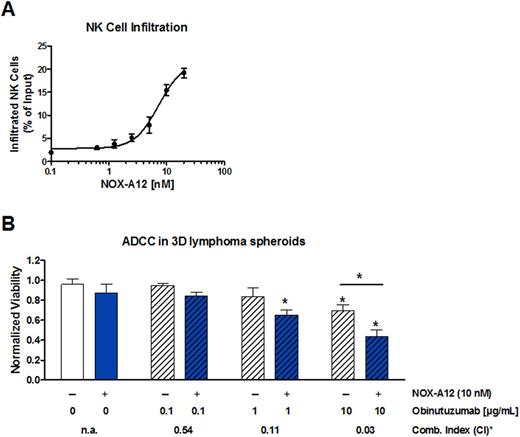Abstract
Hematological malignancies are characterized by the expansion of malignant cells in the peripheral blood and in stroma-rich niches such as the bone marrow or lymphoid tissues. Anti-CD20 monoclonal antibodies (mAbs) are highly effective in eliminating malignant cells in the peripheral blood with the help of immune effector cells, e.g. NK cells mediating antibody-dependent cellular cytotoxicity (ADCC). However, residual malignant cells often continue to persist in protective stromal niches. These compartments have similarities to the solid tumor microenvironment (TME) where mAb therapy is restricted by poor tissue penetration and low effector cell infiltration.
The CXCL12-neutralizing L-RNA aptamer NOX-A12 (olaptesed pegol) has been shown to mobilize malignant cells from the bone marrow into the peripheral blood, thereby sensitizing them to the action of standard therapy such as the anti-CD20 mAb rituximab (Blood. 2014;124(21):1996). In addition to malignant cells, CXCR4 expressing immune cells are effectively mobilized by NOX-A12 (Clin Pharmacol Ther. 2013;94(1):150-157). Recently we have shown that NOX-A12 increases lymphocyte infiltration into solid tumor-stroma spheroids, thereby synergizing with anti-PD-1 checkpoint blockade (Cancer Res 2016;76(14 Suppl): 1473). Here we established 3D lymphoid spheroidal microtissues mimicking the stroma-rich and CXCL12-abundant TME of lymphoid malignancies. We investigated the effect of NOX-A12 on NK effector cell infiltration into lymphoma spheroids and tested the combination with anti-CD20 mAbs.
Spheroids were generated by co-culturing of CXCL12-expressing murine stromal MS-5 cells and CD20-expressing lymphoma cells in ultra-low attachment plates for 24 hours. Primary human NK cells, isolated from healthy donors, were added to the spheroids in the presence of various concentrations of NOX-A12 and an anti-CD20 mAb, either rituximab or obinutuzumab. The next day, spheroids were washed and dissociated for NK cell quantification and lymphoma cell viability determination by flow cytometry.
We found that the ADCC efficacy of anti-CD20 mAbs is lower in 3D spheroids compared to conventional 2D assays due to low NK cell infiltration into the microtissues. Interestingly, NOX-A12 increased the amount of NK cells in the lymphoma-stroma spheroids up to 8-fold in a dose-dependent manner (Figure A), likely by forming de novo CXCL12 gradients into the dense microtissue due to the particular penetration characteristic of L-RNA aptamers. Of note, the NOX-A12-mediated increase of NK cells in the spheroids synergized with both anti-CD20 mAbs tested in terms of NK cell-mediated killing of lymphoma cells (Figure B).
The present work complements the mechanism of action data of NOX-A12 by adding enhancement of NK cell infiltration into stroma-rich tumor compartments to the already established effects of mobilizing malignant and immune effector cells into the peripheral blood. These data as well as the good toxicity profile and the promising data in phase 2a clinical trials in patients with CLL and MM justify further clinical trials in patients with hematological malignancies to verify the greater efficacy of combination treatment using ADCC-inducing mAbs and NOX-A12.
Zboralski:NOXXON Pharma AG: Employment. Kruschinski:NOXXON Pharma AG: Employment. Vater:NOXXON Pharma AG: Employment.
Author notes
Asterisk with author names denotes non-ASH members.


